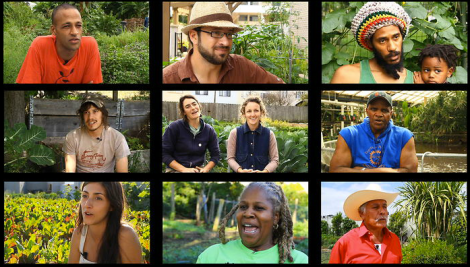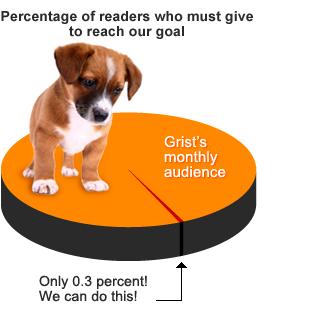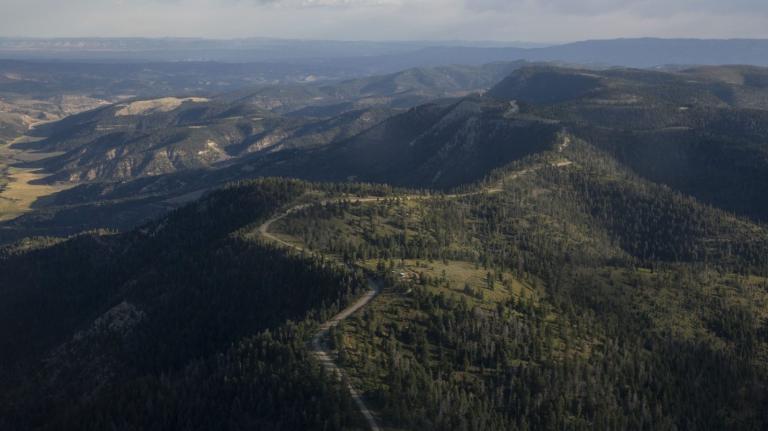
Dan Susman (driving) drove around the country documenting urban farms with his co-filmmaker Andrew Monbouquette.
Fresh out of Dartmouth College and with time on his hands, Dan Susman and his childhood friend Andrew Monbouquette set out on an excellent, edible adventure — a road trip to document many of the innovative urban agriculture efforts sprouting up all over the country.
Susman, now 24, grew up in Omaha, Neb., gardening in the backyard with his mom and dad. He planted pumpkins, named them things like “Big Max” and “Atlantic Giant,” and always hoped come fall he might end up like James and the Giant Peach. No such luck: Evil squash bugs, and ever-looming drought, meant from all those seeds he carefully tended he’d typically end up with just one pumpkin weighing more than he did. But it was enough; a farmer was born.
Since then, Susman has worked on a small-scale farm in Venezuela and for the urban ag-focused Zenger Farm in Portland, Ore. He grew to realize not all kids are as lucky as he: Many never get a chance to plant a bean or taste a watermelon straight off the vine. But with the forthcoming film Growing Cities, Susman hopes to change that.
The independent filmmakers are currently seeking distributors and funding for the feature, which they hope to have ready to screen in 2013. Susman recently shared details about the project and what it’s taught him.

Q. Why did you make Growing Cities?
A. Growing up together in Omaha, Andrew and I were surrounded by some of the country’s most fertile farmland, yet only a fraction of a percent of that land is used to grow produce. As with so many other cities across America, Omaha is filled with fast food restaurants and not many places that offer fresh, healthy food. We wanted to search out alternatives.
Q. There are a lot of food films about urban farming right now — Edible City and Food Forward come immediately to mind. How is your film different?
A. Growing Cities will be the first feature-length documentary to look at urban farming in a national context and weave together farmers’ stories from as diverse places as New York City and New Orleans.
Our film doesn’t just tell the story of the farmers and their communities, but the tale of our trip across America discovering things ourselves. We might have had a preconception that urban farmers are all similar types of people. But we learned on our trip that the community is diverse: We’ve met or known an urban farmer of every age, race, class, and economic situation who is growing food in the city for reasons as diverse as they are. This is not a hippie — or hipster — movement, though there are plenty of each.
Q. You visited with 80 urban farmers; who stood out and why?
A. Something incredible is happening down in the Lower Ninth Ward in New Orleans with Our School at Blair Grocery, a food justice academy. Nat Turner and company are working to empower youth by engaging them deeply with their food system, including planting, harvesting, and selling food to local restaurants. Those kids have stories of struggle — guns, gangs, violence — and every day they work on the farm is a new day for them, in a safe place where something positive happens with their hands. It doesn’t get much better than that.
In terms of a model for financial sustainability, which seems to be the question on many farmers’ minds, Carol Ann Sayle of Boggy Creek Farm has got it down. She and her husband Larry have been farming for over 20 years in Austin — since before there was “urban farming.” They started selling produce to Whole Foods before it became a national brand. She’s inspired three other urban farms to start up within a few blocks, creating an urban agricultural district about a mile from downtown [Austin] that rivals anything we’ve seen.
The best urban farmers work creatively and collaboratively to achieve their goals. A great example of this is City Farm Chicago. They work closely with the city to identify vacant lots that can be farmed in the interim as the land waits to be developed. Once land is identified, they work with neighborhoods to figure out their needs, whether it’s creating green space, growing fresh produce, or providing job opportunities. When it comes time to develop, they pack up their compost and move on to the next site, working to help another part of the city grow.
Q. Did any places stand out?
A. I remember rooftop farmer Ben Flanner of Brooklyn Grange telling us how it was practical to be growing food on a rooftop in N.Y.C. Although it seemed a little strange at the time to think it was practical to take an elevator to a farm and harvest raspberries with a spectacular view of the Manhattan skyline, Ben had a point. As we looked across the cityscape, there was an incredible amount of un-utilized space; all of which seemed like a waste when we saw how much food you could grow on a single rooftop.
In Seattle they have an incredible community garden program, and a whole city department devoted to getting people the land and resources they need to grow food. Detroit has some great urban farm models for economic development, and Milwaukee is becoming the hub for all things aquaponic.
Q. What are some of the challenges that an urban (versus rural) farmer faces?
A. One of the biggest is all of the different tasks an urban farmer must do by default. They not only have to grow food, but they have to be educators, spokespeople, policy advocates, and much more. The degree to which they can juggle all these tasks and still stay focused on their goal, the more effective they are.
Every farmer we met had neighbors (sometimes lots of them) and had to work to get along with them in one way or another. The better the farmers embed themselves and work with their community, the more successful they are. That could mean making partnerships with local restaurants, youth organizations, and rural farmers, or just taking the time to educate their neighbors about what they’re up to.
Q. Each region must have its own unique set of challenges, but what are the common threads?
A. Communities like Detroit and Oakland have seen rampant disinvestment and literally a hundred years of unfair policies that have caused massive social and economic inequality. So, the reasons people are getting into growing food there are different than in communities that haven’t had the same struggles.
That’s not to say the reasons why residents of Berkeley are growing food are less meaningful than those in Oakland, it’s just that it’s more likely they are doing it for health or environmental reasons, rather than to make money or to revitalize their community. And that’s really why I’m working on this film — to make growing food accessible to everyone.
Q. Why do you think urban farming has captured national attention?
A. It allows people to reimagine what’s possible in cities. City farms challenge us to get beyond the urban/rural divide and really think about how we can all be producers in a society that is driven by consumption. I think it’s this quality that is capturing so many people’s hearts and minds, especially during this rough economic time.
It also doesn’t hurt that the scenes of urban farms are really photogenic — think tomatoes sprouting from concrete or chickens on a roof. It all makes for a visual story, where people’s imaginations can run wild.



